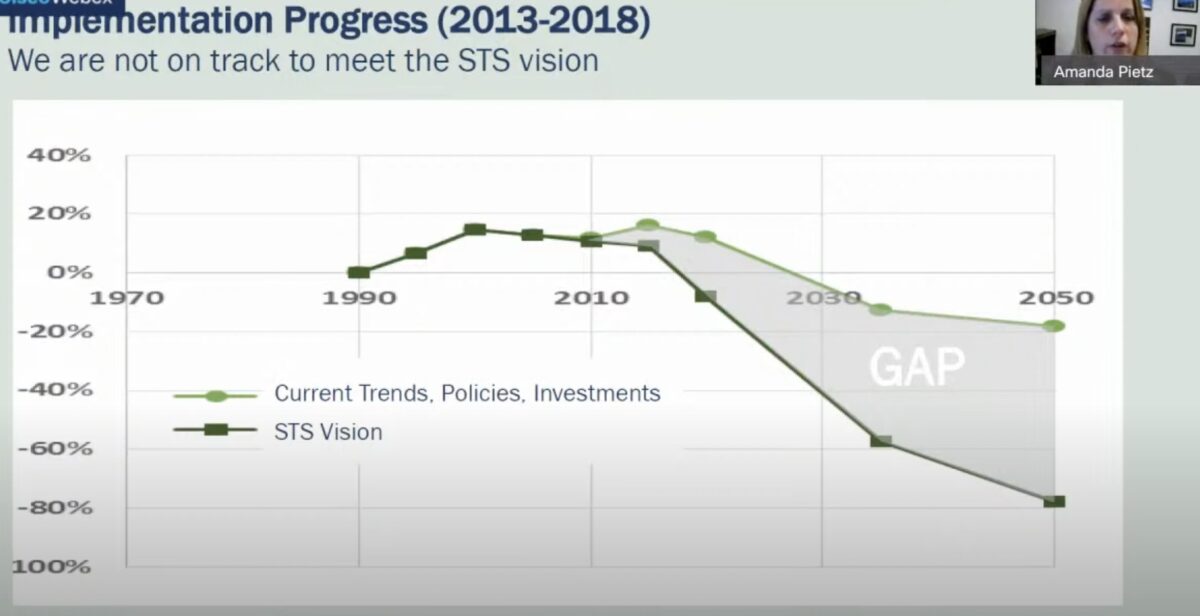
(Source: ODOT Climate Office)
“We have a significant gap between where we are likely to go and where we need to go.”
— Amanda Pietz, ODOT Climate Office
The Oregon Department of Transportation isn’t moving fast enough to meet greenhouse gas (GHG) reduction goals. That’s according to ODOT Climate Office Director Amanda Pietz, who served up the bad news at a meeting of the Oregon Transportation Commission yesterday.
Earlier this summer Governor Kate Brown issued an executive order to reduce emissions to at least 45% below 1990 levels by 2035 and to at least 80% below 1990 emissions by 2050.
During a presentation to the OTC that included a chart on a slide with the word “Gap” between current trends and Oregon’s reduction goals, Pietz said, “We’ve developed a statewide transportation options program, we were able to secure multimodal funding thanks to the legislature — so there’s some positive in there. But those are outweighed unfortunately by the negative people driving more, people holding on to their cars longer, and a lot of fuel inefficient cars on the road. So that’s resulted in an increase in emissions. So, we’re moving in the complete wrong direction… We have a significant gap between where we are likely to go and where we need to go.”
Meredith Connolly, Oregon director for nonprofit advocacy group Climate Solutions, was encouraged to hear this rare bit of candor from an ODOT staffer. “The first step to fixing a problem is admitting you have one,” Connolly shared with BikePortland. “So it’s encouraging to hear an admission from within ODOT’s ranks that they need to step it up on climate. Now we need to see them actually do something about it!”
To that end, Pietz presented OTC members with more about how ODOT plans to close the emissions gap. Or as she put it yesterday: “We’re looking to help turn the ODOT ship… integrating climate means shifting the heart of our practices.”
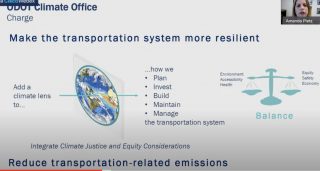
ODOT’s Climate Office was formed this past spring and currently has seven full-time staffers. As a first order of business, Pietz said they’re adding a “climate lens” to everything ODOT does, including how they invest, build, and manage our transportation system.
But she added a caveat: “I’m purposeful in adding the word ‘lens’ to that, because climate will be one factor among many to influence our decisions, and will need to be balanced for safety, equity and other key outcomes.”
Advertisement
The most promising use of this lens will come as ODOT — for the first time ever — will apply it to all projects in its Statewide Transportation Improvement Program (STIP, the list projects must be on before they get funded and built). The 2024-2027 STIP process is just getting underway and it gives ODOT a golden opportunity to make good on climate promises.
Beyond the STIP, the work of the Climate Office has three main parts: mitigation (reducing GHG emissions from the transportation sector), adaptation (creating a system more resilient to floods, fires, evacuation needs, coastal erosion, and so on), and sustainability (initiatives like solar highways, which Pietz said have fallen off the priority list due to other more pressing needs). Pietz said they see the most immediate potential in switching to electric vehicles and encouraging the use of cleaner fuels and she made a point to say EVs stand for more than just cars. “Think of micromobility options like electric scooters, electric bikes, but also on the heavy side like freight and buses.”
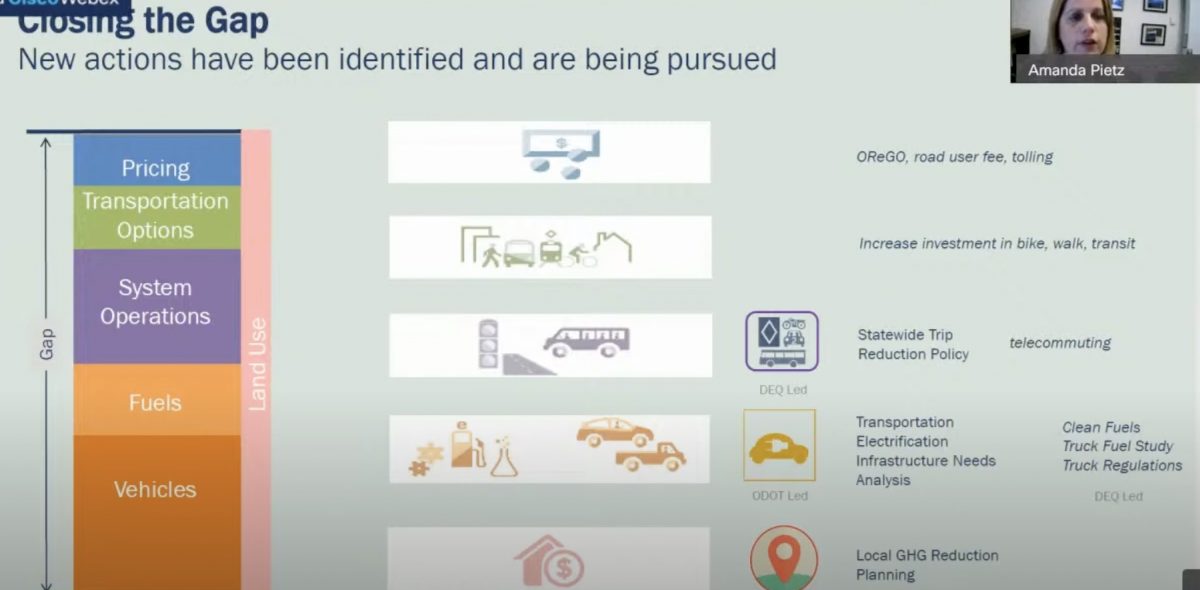
ODOT also sees a silver lining in the Covid-19 crisis. Pietz pointed out that the viability of telecommuting has “been proven” thanks to the pandemic and that the reduction in trips is a positive outcome. “We as an agency really want to support those kind of transitions and we also want to capture the benefits of [telecommuting].”
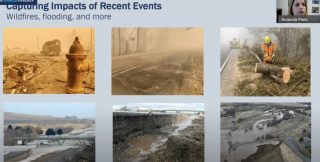
One transition that’s much less positive for ODOT (and everyone else) is how we’ve quickly gone from climate change prevention, to climate change adaptation. In coming years we’ll be hearing much more from ODOT about their role in dealing with climate change related disasters like fires, floods, and rising sea levels. Today, ODOT Director Kris Strickler will go in front of the State Emergency Board to support a $50 million wildfire cleanup project the agency will carry out. The work would go beyond the right-of-way and represents a new direction for ODOT if we assume “climate fires” (which is how new OTC member Maurice Henderson referred to them in the meeting yesterday) will become the future norm. It also which sets up a conflict of interest because ODOT’s failure to reduce GHG emissions and their car-centric planning are directly related to the intensity and of the recent fires and Strickler himself believes widening highways leads to lower emissions.
To reach climate goals ODOT must do more to reduce vehicle miles traveled (VMT). A statewide analysis by Climate Solutions published last month (PDF) found that the best scenario combines reduced VMT with electrification.
Investing more in “transportation options” (not driving) is a part of ODOT’s strategy (see chart), but it remains to be seen whether they can steer their ship far enough away from the sirens of auto capacity to move the needle for bicycling, transit, and micromobility.
Pietz is optimistic: “The Governor’s executive order was a recognition that we need to get back on track. The good news is that we can catch up. That gap is achievable.”
— Jonathan Maus: (503) 706-8804, @jonathan_maus on Twitter and jonathan@bikeportland.org
— Get our headlines delivered to your inbox.
— Support this independent community media outlet with a one-time contribution or monthly subscription.



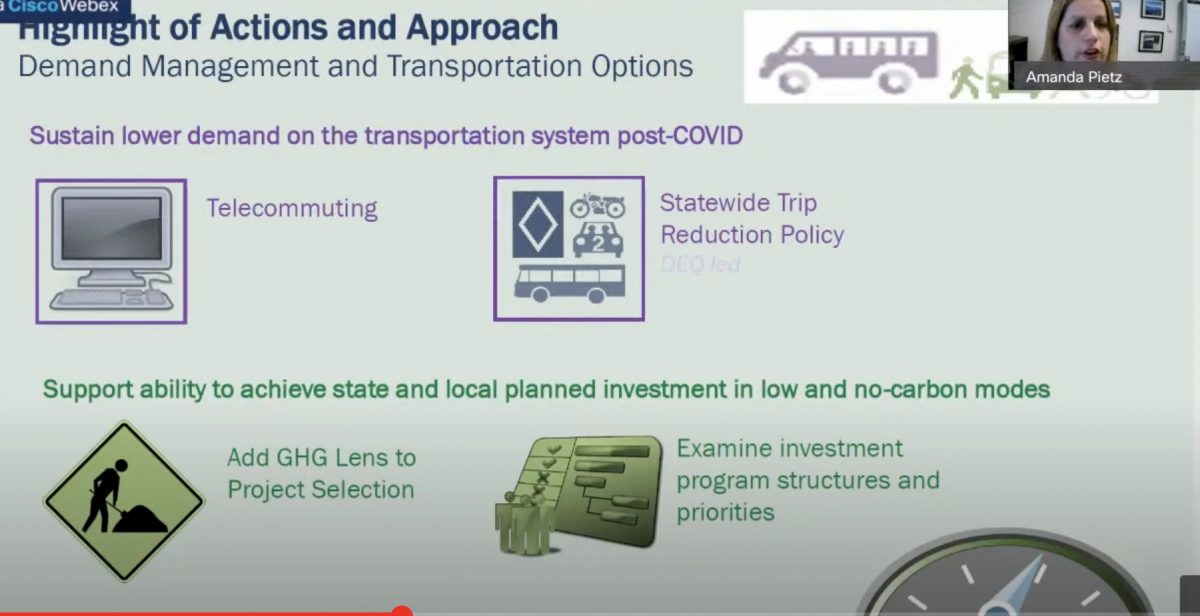

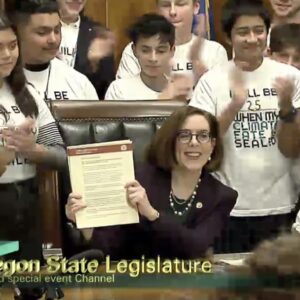
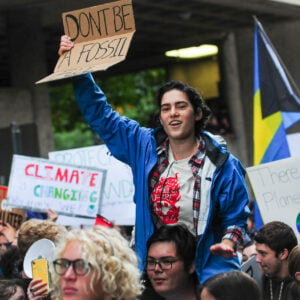
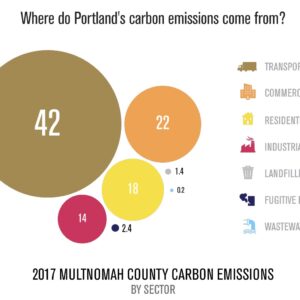
Thanks for reading.
BikePortland has served this community with independent community journalism since 2005. We rely on subscriptions from readers like you to survive. Your financial support is vital in keeping this valuable resource alive and well.
Please subscribe today to strengthen and expand our work.
Let’s start with the Rose Quarter project (and the other regional highway expansions they’re doing that are getting far less attention).
the problem with ODOT is that they don’t see highway expansions as running counter to GHG emission goals. In fact they (Director Strickler especially) believe reducing congestion and reducing idling cars by clearing out “bottlenecks” is a good way to meet climate goals. It’s insanity, but it is what it is.
Is that not the real issue here? There is a clear ideological-based discrepancy between what research actually suggests, and what ODOT often states. When we look at research, we want to find the best or strongest evidence. Expert opinion and anecdotes are near worthless. Meta-analyses and RCTs are more robust.
ODOT can state they accept the climate statement and work of 7 staff among thousands, and continue offering pseudo-science in support of an often singular goal of expanding car-centric infrastructure.
It is possible one of the few ways to persuade ODOT into building infrastructure other than for car capacity, speed and storage, may be to mandate this by law. For example, their budget must commit x amount to separated infrastructure per year. The bike bill can be amended to explicitly define bicycle and walking infrastructure as “physically separated.” The legislature can require any car infrastructure to undergo a full EIS as opposed to an EA. There are a lot of steps that will mandate change rather than simply hoping they will follow the best data, something it appears they have avoided for many decades.
The engineers and all the other staff at ODOT (and most other DOTs) are trained to build highways – that’s what they do, and that’s really all they are capable of doing. Their incomes are based on successfully getting funding for infrastructure projects, from state taxpayers, the feds, local cities and counties, and Metro – without that funding, they would be having to look for work with private contractors.
If we want to meet climate goals, we essentially need to end an entire industrial sector related to highway building and design, and put a lot of highly-paid civil-engineering types out of work.
If the State/Federal Government invested what is actually required to maintain our current infrastructure there would still be plenty of jobs. I am sure the existing skills at ODOT could be used to develop regional connections for alternative modes, maybe even look to German and instead of recreating the Autobahn we could have their bicycle highways.
Having actually taken transportation engineering classes, I can tell you that while that’s all traditional traffic engineers have been capable of doing, today’s engineers are being trained differently. That doesn’t help us much today, but “all they are capable of doing” ignores the newer engineers who would like to change things but aren’t yet empowered to do so. And there are plenty of other infrastructure-engineering projects for them to do besides building highways.
PBOT has also jumped on the “faster roads are good for the climate!” train. See: Better Hawthorne
The governor and legislative majority say climate change is serious but keep appointing, confirming and funding transportation officials that make ridiculous claims like wider freeways are good for the climate. Transportation is the number one thing the state can do about climate change. They’ say they’re “serious,” but they act ridiculous. It’s long since time the media and voters call them on it.
And despite these protestations most progressives and liberals keep on voting for these climate science-denying corporatists.
Bingo. Everything needs to be electrified, and all of the fossil sources of electrical power generation need to be taken offline ASAP. Boardman, which shut down last Thursday, is a good first step.
Over the next decade, the vast majority of new car sales will switch to being EVs. Then the older cars will start to come off the roads.
Note that Joe Biden has a $2 TRILLION decarbonization plan that focuses heavily on flat out eliminating gas powered cars. Also, it should be noted that Biden REALLY loves trains. Like, a lot. He’s a train guy.
Here’s some links:
Joe’s plans:
https://joebiden.com/clean-energy/
https://joebiden.com/climate-plan/
https://www.autoblog.com/2020/07/14/biden-climate-plan-jobs-infrastructure-clean-energy-cars/
“I would transition from the oil industry, yes,” Biden said later. “It’s a big statement because the oil industry pollutes significantly. … It has to be replaced by renewable energy over time.”
https://thehill.com/policy/energy-environment/522397-biden-i-would-transition-from-the-oil-industry
Obama and Biden both dropped the ball with the super highspeed rail flop. If we were serious about going electric or super high speed we would have to hire a bunch of overseas (Chinese) engineers who can actually build this type of network. The type of engineers needs to change drastically and how we operate.
You don’t have to hire Chinese to do high speed rail. You just need to use the same techniques. The Chinese don’t have to ask for citizen input because they are a highly repressive authoritarian government. For example they put millions of people in re-education camps because they are Muslim. If the Chinese government wants to build a rail line through your city and that means the whole place is bulldozed then that is what happens. There is no appeal. It is a lot easier to build infrastructure when the government can do whatever it wants whenever it wants and jail anyone that disagrees.
“they are a highly repressive authoritarian government”
Milk jug calling sugar jar white.
When ODOT starts rounding up and imprisoning its opponents, I’ll give your comment a thumbs-up.
“Boardman, which shut down last Thursday…”
The Boardman Plant was replaced with a fracked-gas generation plant. Moreover, Portland’s fossil fuel-centric generation won’t change much because PGE still owns two large coal generation plants in Colstrip Montana and PacifiCorp generates the dirtiest coal-centric electricity in the PNW. In Portland, a Tesla EV powered by PacifiCorp’s energy mix generates more carbon pollution than a gas-burning Camry.
“Over the next decade, the vast majority of new car sales will switch to being EVs.”
A bill that would have implemented a transition to EVs over several decades was laughed out of the CA legislature. The idea that there is anything close to broad support for mandatory electrification of SUVs and pickup trucks in the USA is comical. The false hope that quick and easy technological fixes will save us is a form of climate science denial that the democratic party has perfected to an art form.
Until we implement the systemic changes that Biden and other democrats fiercely oppose, electrification is nothing more than green washing.
https://www.nytimes.com/2020/09/23/climate/california-ban-gas-cars.html
It’s not nearly enough, but it’s one necessary step.
One has to wonder if ODOT couldn’t be a better environmental steward of the land next to roads. Carbon sequestration may not be the solution, but it is part of the solution. Even “greenwashing” our roadsides would add to the betterment.
It’s not just local transportation options though. I often wonder how the money we throw at our freeway budget would go on things like double-tracking the Portland-Eugene mainline that Amtrak takes, and working with WSDOT to do the same to Seattle. Frequency, more than speed, is the reason I’ve not been able to take the train to Salem/Eugene for a number of my last trips, and frequency is the WHOLE reason my buddy (who works for Facebook up in Seattle) isn’t able to just Amtrak it up there & back. He’d far rather work on the train and not have to drive, but one daily train each way basically assures that he’ll never have a train that works with his schedule.
Everyone wants to talk about high speed rail, and I get that, but double-track & electrify the current corridor (which is already good for 80mph+ most of the way) and that opens up a ton of flexibility to offer usable transportation options for mid-distance intercity travel that could get a lot of cars off the road.
Or even building a German-style ICE rail line outside of the current UP/BNSF mainlines, through extensive tunneling? Siemens AG seems to have perfected the process and has brought the costs down so as to be “affordable” compared with highway building, while keeping the track spaced at standard gauge to allow any train to use the track and to merge with the existing track network. Even old diesel trains can run on ICE track, as well as Eurostar, Thalys, and TGV (with overhead electrification).
Indeed. And it doesn’t even have to be ICE-style. If you look at the Zurich -> Munich intercity service or even the Stockholm->Gothenburg->Malmo X2000 service in Sweden, that’s not even on purpose-built high-speed track. But it’s really frequent and it’s fast ENOUGH. There’s no denying how little you need to drive when there’s city-center to city-center service that you can bike-share or tram to, it basically removes any notion that you’d do something primitive like get in a car and drive for 3 hours.
I agree. The foot-dragging from the State on a rail line between Eugene and Portland is criminal. And we should have a efficient and reliable commuter rail between Salem and Portland, eventually extending to Vancouver, WA. But they find the money to study widening I-5 in Portland and building lanes around Salem.
> I often wonder how the money we throw at our freeway budget would go on things like double-tracking the Portland-Eugene mainline that Amtrak takes
I wonder that too, but you won’t find out from ODOT. I think they have more people working in their tiny tiny Climate Office (7) than they do in their rail division (something like 5 last time I checked).
Aside from the Point Defiance tunnel, PDX – SEA is double or triple tracked. The Point Defiance bypass will avoid this bottleneck, whenever WSDOT decides to start using it.
Electrification is a bigger issue, since the tracks are shared with freight traffic. It can be done, but the host railroads would have to agree to it.
Increasing frequency (and to a lesser degree speed) is essential to the Cascades service. Electrification would reduce its carbon footprint, sure, but that’s already far lower than the cars it replaces. As it is, the existing diesel trains are already capable of 130 mph, but major track and crossing improvements are needed first (and need to get used, as Chris points out). I’d prioritize those things over electrification here.
Is it really though? It depends on the occupancy of the vehicles (both train and car). I read somewhere that Max had the equivalent energy use of all passengers driving small single-occupant cars, and that’s electric, and replaces urban driving rather than more efficient (less inefficient?) highway miles.
It may be that you’re right, but I would not just assume that you are on the basis that transit is always better.
I don’t have the link handy, but I saw a per-passenger analysis of mpg-equivalence for various transport modes a couple years ago. IIRC electric trains were 200-300 pMPGe, and diesel trains were 100-150. I’d guess average passenger occupancy in cars traveling on I-5 between Eugene and Seattle is less than 2, and the average vehicle mpg is probably 25. Even a Prius (getting a bit less than 50 mpg at the 75mph that most people do on I-5) with 2 people in it is going to emit more carbon than a diesel train.
I can’t see how ODOT is set up to achieve climate goals. Their focus is roadbuilding…
It’s too bad we can’t set up regional transportation authorities like we do with hydropower, BPA and TVA being the classic multi-state examples. An independent multi-state public agency that taxes jurisdictions on the number of paved miles they have, and uses that funding for both local maintenance and certain regional projects such as HSR, raising additional revenue through tolls, all managed by corporate staff rather than political appointees.
If jurisdictions wanted to reduce their taxes paid, they would have to remove paved roads, likely reducing overall VMT in the process.
ODOT should be required to apply the “climate lens” on existing projects, starting with next years budget instead of future projects (2024-2027)
How ironic to see the headline, “Leader of ODOT Climate Office: ‘We’re moving in the complete wrong direction’”, then scroll down and see the first “Related Posts” headline: “Oregon Senate confirms ODOT director who says freeway widening is a climate change strategy”.
Amanda Pietz is a left over employee of Matt Garret hires. I observed her at previous OTC meetings. She oversaw the bike program and reported to the OTC in 2019 that her office only put down 1 lane of cycle mile per year between 2009 and 2019. She wasn’t hired to be successful. She was hired to fill a role and in my observations this was a cushy job for her to manufacture consent that ODOT was doing something for cyclists, but actually never did much.
I’m not really surprised she got this ‘promotion’. For Strickland, just getting someone hired in a new office was the goal. Getting people who will actually get the job done is a whole other story. I didn’t watch the meeting but unless they are talking about actually removing lane space for cyclists and protected bike lanes, this is all just window coverings on an agency that doesn’t really care about protecting cyclists.
Yes, I’ve met many others who have her role in their agencies, including at PBOT. Nearly all continuously face a regular dilemma – do they do the job the public expects of them to advocate forcefully for bike and walk infrastructure and positive policies, and risk losing their jobs and promotions? Or do they go with the flow, do the minimum, make the right passive noises, and steadily move up the bureaucracy? Guess which scenario nearly all of them choose?
Most people do the job their boss tells them to do. Pietz works for ODOT, not (directly) for the public. The public’s point of leverage is elected officials, who work directly for us (at least theoretically), and, if they want to keep their job, should be responsive to our concerns.
If you want ODOT to be more responsive, it might help if Kate Brown felt less secure in her job, and had more need to give voters what they ask for. Voting Democratic in every race on the ballot (as I imagine many of us do) does not necessarily make incumbents feel the pressure to make the changes their constituents demand.
Of course, there’s always the danger that what the larger public wants is not what we want, so responsive public officials might not be in our best interest.
“The public’s point of leverage is elected officials, who work directly for us (at least theoretically)”
I appreciate those parentheses – but follow the money. They don’t work for us; they were mostly bought with corporate cash. Oregon’s campaign finance situation is worse than terrible.
Wow, the thought of a state DOT with a climate office is like a Klan chapter with an African-American outreach office!